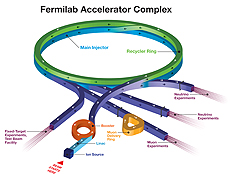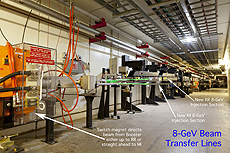First beam circulates in the Recycler
 |
| Fermilab's reconfigured accelerator complex now allows operators to send proton beam from the Booster into the Recycler for slip stacking and then transfer the beam from the Recycler into the Main Injector for final acceleration and production of neutrinos for the MINERvA, MINOS and NOvA experiments. Image: Fermilab |
On Friday, Fermilab took another significant step toward a fully operational accelerator complex: first beam through the revamped Recycler storage ring since the accelerator complex shut down in April 2012.
Now that beam has circulated through the Recycler, the Accelerator Division will begin making adjustments, great and small, to the Recycler and learn how the proton beam responds.
"Having beam means we can start to parameterize the machine, get going," said Dave Capista, deputy head of the Main Injector Department.
The Recycler is one of four primary stages in Fermilab's updated accelerator complex. It will play a major role in increasing the beam output of another accelerator stage, the Main Injector, which saw beam for the first time just over a month ago.
Accelerator operators and experts will now begin commissioning the Recycler and preparing it for a process called slip stacking, in which bunches of beam are squeezed together. This is a crucial step in increasing the number of protons that the Fermilab accelerator complex can deliver in the future to various experiments.
In its previous life as part of the Tevatron program, the Recycler was used to store antiprotons. Slip stacking occurred in the Main Injector, which also had to accelerate the beam.
Now in its new role, the Recycler will be responsible for slip stacking. This will allow operators to accelerate beam in the Main Injector more frequently, significantly cutting down the amount of time it takes for the Main Injector to deliver a beam pulse. The goal is a pulse of protons every 1.3 seconds, compared to 2.2 seconds before the shutdown.
With more rapidly delivered protons, the Main Injector will ultimately be able to deliver 700-kilowatt beam, roughly double its previous power.
"The Recycler is the key to getting to 700 kilowatts," said Ioanis Kourbanis, head of the Main Injector Department. "The Main Injector can't do it on its own."
The commissioning process will take several months.
"Some people say, 'Once the shutdown is done, we can go to 700 kilowatts.' It's not that trivial," Kourbanis said. The Accelerator Division will go through every Recycler system one by one — the radio-frequency power system, beam instrumentation, magnets — commissioning each and troubleshooting along the way.
"For all practical purposes, it's a new machine," Capista said. "We have to treat it as you would a new machine."
The accelerator team looks forward to the moment when beam can zip through the Recycler, hop over to the Main Injector and accelerate through it without a hitch.
"When we get slip stacking in the Recycler, well, that's big," Kourbanis said. "That means, '700, here we come.'"
Fermilab will host a labwide celebration to mark the official startup of its accelerator complex this fall.
—Laura Dattaro
 |
| The Accelerator Division has been busy upgrading the Recycler to get it ready for higher-power beams. On Friday, protons circulated through the Recycler for the first time since the 2012 shutdown. Photo: Marty Murphy, AD |
|